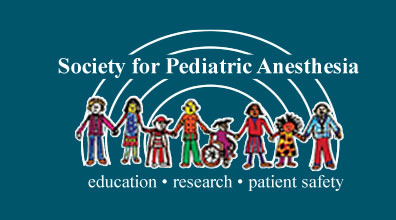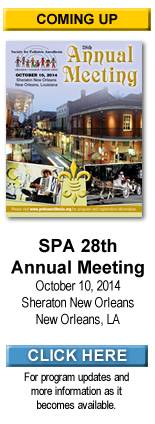SPPM Meeting Reviews
Session 1: Developmental Aspects of Pain
Reviewed by Rita Agarwal MD, FAAP
Children’s Hospital of Colorado
 Pain in Infancy & Childhood: A short and long term view - Maria Fitzgerald, BA PhD FMedSci (University College, London)
Pain in Infancy & Childhood: A short and long term view - Maria Fitzgerald, BA PhD FMedSci (University College, London)
Dr. Maria Fitzgerald is a world renowned researcher and speaker on the topic of pain in developing animals. She discussed the neurobiology of pain processing and the effects of growth and development. There are important differences in acute pain processing with age and understanding and appreciating these variations can lead to improved treatments in the future.
Animal studies reveal that exposure to untreated pain and stress may “prime” the system so that subsequent injury later in life can be more significant. Persistent and chronic pain syndromes rarely occur in children younger than 4 year old. Infants do not seem to get neuropathic pain. This is also true in young rodents. Nerve injury does not trigger neuropathic pain-like behaviors in these animals, however they can have increased hypersensitivity with the onset of adolescence.
In adults, injury to the nervous system leads to the release of inflammatory cytokines; in contrast in the young, anti-inflammatory cytokines are released. These cytokines do not excite the neurons and do not cause pain. Blocking the anti-inflammatory cytokines can unmask this effect.
Sucrose is a substance that has been used for “analgesia” in young infants and animals. However despite behavioral changes (and decreased outward signs of pain or stress), there are no EEG or EMG changes indicative of analgesia. Animal studies have shown that animals would rather eat (hedonic foods) than react to pain. French Fries anyone?
Developmental pharmacokinetics/pharmacodynamics of Parenteral Opioids and NSAIDs in Infants: What are the problems? - Anne M. Lynn, MD (University of Washington, Seattle Children’s Hospital)
(Taken directly from Dr Lynn’s handout for the sake of clarity)
Definition of terms:
- Clearance = volume (usually blood or serum) from which a drug is removed in a unit of time, corrected for weight in pediatrics
- Volume of Distribution = volume necessary to account for measure concentration after a particular drug dose Small Vd is seen in drugs that don’t cross cell membranes easily due to large size, ionization or extensive binding to serum proteins
- Half-life is a time term (min, hr) which represents the time needed to change drug concentration by 50%. Elimination half-life, t ½, occurs due to metabolism – renal, hepatic or other pathways and excretion of unchanged drug.
Dr. Lynn is an internationally recognized researcher clinician in the area of medication PK/PD studies; she reviewed hers and other’s studies in this area focusing on the opioids morphine and fentanyl, as well as the NSAID ketorolac. Her initial studies were on morphine infusions in infants undergoing cardiac surgery.
She and her colleagues found a lower volume of clearance, higher volume of distribution and a prolonged ½ life in infants until they reached about 6 months of age. Respiratory depression and hypercarbia correlated to serum concentration of morphine >20ng/ml, and there was a great deal of inter-patient variability-3-4 fold times. The same appears to be true for other opioids. This makes kinetic modeling studies in the young challenging and dosing of patients should still be done on an individual basis. There are ongoing studies looking at the effect of race, ethnicity and genetic factors on pharmacokinetics.
Ketorolac is comprised of 2 stereo-isomers. The S-isomer is the most potent analgesic and more rapidly cleared. Dr. Lynn’s studies have found a single dose of the S stereoisomer in young infants 2-18 months of age to be safe and effective. The R isomer accumulated after repeated doses and it potential toxicity is unclear at this time.
Session 2: What’s New in Regional Anesthesia?
Reviewed by: Karen Dean, MD
Children’s Hospital of Colorado
 The second session, moderated by Dr. Robert Wilder (Mayo Clinic) began with a lecture by Dr. Arjunan Ganesh MBBS (Children’s Hospital of Philadelphia) on ambulatory peripheral nerve block catheters in children.
The second session, moderated by Dr. Robert Wilder (Mayo Clinic) began with a lecture by Dr. Arjunan Ganesh MBBS (Children’s Hospital of Philadelphia) on ambulatory peripheral nerve block catheters in children.
The lecture started with a brief literature review, and demonstrated that continuous perineural infusions are becoming more and more common in pediatrics. The reasons for this steady swell in popularity are abundant, and include effective analgesia, decreased opioid exposure and opioid-related side effects, earlier mobilization and hospital discharge, increased patient satisfaction, and lower hospitalization costs.
Dr. Ganesh then gave a detailed description of the CHOP experience with ambulatory continuous peripheral nerve blocks, summarizing the results of their newly-published case series (Gurnaney et al. Anesth Analg 2014). This report of 1492 ambulatory catheters includes a variety of catheter sites, surgical indications, and nerve localization techniques. Complications were encountered infrequently and almost all were minor in nature.
Next, Dr. Ganesh had some useful advice for those looking to start an ambulatory block program. He discussed the team members, equipment, education, and follow-up infrastructure that are essential to making these programs work. There were several clinical pearls shared, including a suggestion to bolus through the catheter and not the needle, and thus reduce the risk of discharge with an ineffective catheter. These sound principles will surely aid many providers seeking to implement this safe and effective mode of pediatric analgesia.
The next lecture was an update on the current evidence regarding adverse events in pediatric regional anesthesia, provided by founding co-chair of the Pediatric Regional Anesthesia Network (PRAN), Dr. David Polaner (Children’s Hospital Colorado). To date, prospective data on the complications of pediatric regional anesthesia have been limited to 4 large trials, and individual centers may have inadequate case numbers to guide evidence-based decisions. As we wait for continued accumulation of PRAN data, it is time to pause and examine the current state of the evidence.
First, regionalists have many choices when it comes to local anesthetics and their dosing. At least in animals, ropivacaine does seem to be less toxic than bupivacaine, producing toxic symptoms at higher blood levels. Ester anesthetics like chloroprocaine may be safer still due to rapid clearance by ester hydrolysis, but data remain limited. Pharmacokinetic studies of local anesthetic infusion reveal that alpha-1-acid glycoprotein levels increase during infusion, so even though local anesthetic accumulates, the concentration of unbound local anesthetic does not rise significantly. This confers some natural protection against toxicity with infusions.
Several additives have been suggested for pediatric blocks. The data on clonidine is mixed, but generally favors prolonged analgesia when added to neuraxial blocks, and possibly peripheral blocks as well. One study compared clonidine given caudally with clonidine given intravenously, and concluded that clonidine exerts its analgesic effect via a spinal mechanism. Caution with dosing is recommended, as clonidine can cause significant sedation, especially in the very young.
The widespread introduction of ultrasound has been a boon for regional anesthesia. Potential benefits include improved accuracy of needle placement, lower block failure rates, and reduced inadvertent vascular punctures. Polaner cautions though that nerves live near blood vessels, so improved accuracy of needle placement will lead to higher systemic absorption of local anesthetic if dosing is not reduced.
Imaging can be helpful with neuraxial analgesia as well. Epidurograms are recommended if threading caudal catheters, in cases of difficult epidural placement, and whenever there is ineffective analgesia or otherwise unexpected results. Taenzer’s database of 724 pediatric epidurograms (RAPM 2010) revealed a 1.6% rate of unexpected epidural misplacement, including a striking 0.7% incidence of IV placement with negative test dose. It is important to realize that test doses may not always produce reliable alterations in heart rate or T wave amplitude, especially during TIVA. Incremental injection of local anesthetic is a must.
Dr. Polaner’s lecture also provided some validation for pediatric anesthesiologists, with their long-held belief in the safety of performing regional blocks under general anesthesia in children. Emerging data from the PRAN database supports lower rates of local anesthetic systemic toxicity, neurologic sequelae, and overall complications when children are blocked under general anesthesia vs. awake. Publication of this data will only be the latest in a series of useful discoveries made possible by the multi-center collaboration of PRAN.
The next lecture, delivered by Dr. Constance Houck (Boston Children’s Hospital), focused on pain management after minimally-invasive surgery of the chest and abdomen. Isn’t the whole point of minimally-invasive surgery that it’s not supposed to hurt? Unfortunately not.
Dr. Houck reminded the audience that small incisions do not necessarily mean small pain. In fact, in the case of chest surgery, the adult literature shows us that while thoracoscopy reduces acute pain relative to open thoracotomy, it still results in intense pain of short duration. Rates of chronic post-surgical pain are the same.
There are three key sources of pain after thoracoscopy – incisional pain (somatic), nerve irritation pain (neuropathic), and ipsilateral shoulder pain (referred). The shoulder pain, thought to result from pleural and pericardial irritation, occurs in >50% of open thoracotomies and 20-47% of VATS procedures, meaning that it is still a very significant source of pain despite a minimally invasive approach.
Approaches to pain management after thoracoscopy are multi-modal. Thoracic epidural, the gold standard in open procedures, is not recommended unless thoracoscopy will occur bilaterally. Thoracic paravertebral, intercostal, and intrapleural analgesia are all reasonable alternatives with good efficacy and safety profiles. The analgesic plan can also include adjuncts such as preemptive local injection of port sites, NSAIDs, acetaminophen, transcutaneous electrical nerve stimulation (TENS), and gabapentinoids. Some groups are also experimenting with interscalene blocks or injection of the peri-phrenic fat pad as a means of reducing referred shoulder pain.
Adult data with laparoscopic surgery reveals that it too is a painful experience, with a high proportion of patients reporting incisional pain, diffuse abdominal pain, and shoulder pain. Also, in one study, approximately 12% of patients went on to develop chronic pain, and only 5% had a pathologic explanation for ongoing pain.
Analgesia for laparoscopic surgery can include incisional local anesthetics, dexamethasone, NSAIDs, and opioids.
There has also been recent interest in the use of intraperitoneal local anesthetics for these procedures, either through aerosolization devices or nebulizers. The nebulizer devices emit local over a longer period of time and create “fog” in the surgical field, but seem to work better and result in safer serum anesthetic levels.
Interestingly, though, preliminary data from Boston suggests that nebulized saline may work just as well, raising the question of whether prevention of peritoneal desiccation is the true cause of improved analgesia. Future studies will investigate the use of warm humidified CO2 in the abdomen.
Session 3: Pain Management is About Risk Management
Reviewed by Rita Agarwal MD, FAAP
Children’s Hospital of Colorado
Prescription Drug Abuse in Teenagers and Risk Assessment: Current Controversies: Jeffrey Galinkin MD, FAAP (University of Colorado, Children’s Hospital Colorado, AAP Committee on Drugs)
By far the scariest session I have attended! Drugs are all over, kids are getting them from us or our friends!
Dr. Galinkin started this session by reviewing the definition of addiction, dependence and tolerance and then laid out the scope of the problem in our young people. The number of prescription opioids has increased 4 fold from 1999 to 2010, and for drugs such as methadone and oxycodone, the sales have increased approximately 1000%.
The number of ED admission and deaths has paralleled this increase in sales. High school students are more likely to try opioids and the majority of teenagers that do, get the medication from their home or from a relative or friend. Almost 50% of high school seniors perceived the availability of prescription opioids to be “easy” and almost 10% had tried prescription opioids (for non-medical use) in the past year.
In one study the vast majority of parents stored their children’s opioid prescription medication in an unsupervised location. Children and parents believed that because it was prescription, it was safer and because it was their prescription it was OK to use more if they needed to.
Another study showed that left-over prescriptions were a major source of nonmedical use of oral opioids. One way to make opioids safer is to combine them with naltrexone, and the first such product was approved in November 2014. Others include simple steps such as prescribing only what is needed; encouraging parents to count pills and keep medication under lock and key; telling families how to dispose of their unused opioids (most should be flushed down the toilet); and educating them on the dangers of prescription drug abuse.
Drug Diversion by Your patient: REMS and YOU - the Opioid Prescribing Physician. Keith Berge, MD (Mayo Clinic Rochester, Chair- ASA Task Force on Chemical Dependency)
Diversion is the transfer of a controlled substance from a lawful to an unlawful use. Use of medication waste or using someone else’s pills is diversion. There is an epidemic of diversion and prescription abuse in the United States. This, as mentioned in the talk above is at least due to availability, perception of safety compared to street drugs and profit.. Unintentional opioid overdoses are increasing dramatically while unintentional heroin and cocaine overdoses are staying relatively stable.
Opioids should continue to be prescribed as indicated, care must be taken to DOCUMENT everything. Prescribing physicians and their proxies are contributing to the problem of rampant misuse of opioids. In an effort to combat this trend the FDA announced elements of the Risk Evaluation and Mitigation Strategy (REMS). Specific information regarding assessment, initiation of therapy, modification, counseling, monitoring etc. are all part of this strategy. More information is available at:
https://search.er-la-opioidrems.com/Guest/GuestPageExternal.aspx
Finally, Dr. Berge discussed when and how to involve Law enforcement Services. There is no consensus on this, and it is a frequent struggle among practitioners. However, any significant loss must be reported to the DEA within one business day. Any theft of controlled substances must also be reported. HIPAA does not protect information/activity that may be associated with a crime.
Session 4: PRO and CON Debate: Peripheral Nerve Blocks vs. Central Blocks
Reviewed by Karen Dean, MD
Children’s Hospital of Colorado
The first annual SPPM meeting concluded with a pro/con debate, with last year’s popular debate stars Dr. Constance Monitto (Johns Hopkins Children’s Center) and Dr. Stephen Hays (Vanderbilt University Medical Center) returning for a grudge match.
Dr. Hays kicked off the debate by giving his Top-10 reasons why peripheral nerve blocks should reign supreme over central blocks. Reasons to champion peripheral nerve blocks include their effectiveness, versatility, and long history of clinical use. They can be just as effective as neuraxial blocks, but avoid some of the complications of neuraxial anesthesia including urinary retention, nausea, spinal hematoma, paraplegia, and post-dural puncture headache.
Peripheral nerve blocks can be performed easily with ultrasound, possibly increasing speed and accuracy. Less drug can be used, with as little as 0.075 mL/kg providing an effective ilioinguinal block compared to 1 mL/kg for a caudal.
The strength of Dr. Hay’s argument really rested in two key points, though. The first is that peripheral nerve blocks are exquisitely specific, putting the anesthetic only where the pain is located. The second is that peripheral nerve blocks are portable, and being able to leave the hospital with a peripheral catheter is a clear advantage in terms of hospitalization costs and patient satisfaction.
When Dr. Monitto took the stage, however, she was certainly not ready to concede. She argued that neuraxial anesthesia also has historical longevity, versatility, and clear effectiveness. Epidurals have been shown to reduce stress response and provide beneficial respiratory effects in the perioperative period, maybe even decreasing the need for post-op ventilation. Neuraxial anesthesia is also unique in that it can be used as the sole anesthetic for a number of surgical procedures. Spinals and epidurals are also simple to perform, not requiring fancy localizing techniques or expensive equipment.
After both speakers had finished, it seemed like the debate was fairly close. Both techniques are generally safe, effective, and adaptable. Both techniques also emerge as the clear winner in specific scenarios – for instance, epidurals win for exploratory abdominal surgery, and peripheral blocks win for ambulatory orthopedic surgery.
To break the tie, consider this insightful question from an audience member – if you were the patient, and your pain could be totally covered with either a peripheral or a central block, which would you choose? If you can answer that question, we have a winner.


